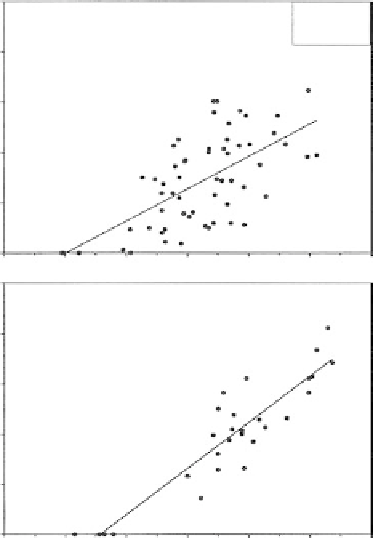Agriculture Reference
In-Depth Information
10000
CONVENTIONAL TILLAGE
Y = -1310 + 128.90X
n = 59 r
2
= 0.409 RMSE = 1388 P<0.0001
TRIBUNE
1973-2003
8000
A
6000
4000
2000
0
10000
NO TILLAGE
Y = -2889 + 184.17X
n = 28 r
2
= 0.834 RMSE = 938 P<0.0001
B
8000
6000
4000
2000
0
0
10
20
30
40
50
60
WATER SUPPLY: ASW + PRECIP. (cm)
fIguRe 19.4
Grain sorghum yield at Tribune, Kansas, associated with water supply (plant-
available soil water at emergence plus growing-season precipitation) for dryland conventional
tillage (section A) and for no-till (section B) treatment groups. RMSE, root mean square error.
(From L.R. Stone and A.J. Schlegel, 2006,
Agronomy Journal
98:1359
-
1366.)
efficiency. Stone and Schlegel (2006) summarized almost 30 years of grain sorghum
yields for western Kansas produced using conventional tillage compared to no tillage
(Figure 19.4). There was a relatively straight-line relationship between the yield of
grain and the water supply (available soil water plus growing season precipitation,
and this was approximately equal to evapotranspiration), as would be expected in
view of the generalized relationship presented in Figure 19.1. With no tillage, how-
ever, the slope of the line is greater, indicating that more grain was produced from a
unit of additional water compared to that produced from an additional unit of water
using conventional tillage.
i
n C r e a s i n g
t h e
h
a r v e s t a b L e
P
of r t i of n
o f
a
g r of n of m i C
C
r o P s
The harvestable portion of agronomic crops can be increased by plant breeding and
genetics and by management. Corn, rice, and wheat are the most widely grown grain
crops in the world, and corn and wheat in particular are grown under a wide range of
water conditions. Water stress is common in these crops and can have a major effect

